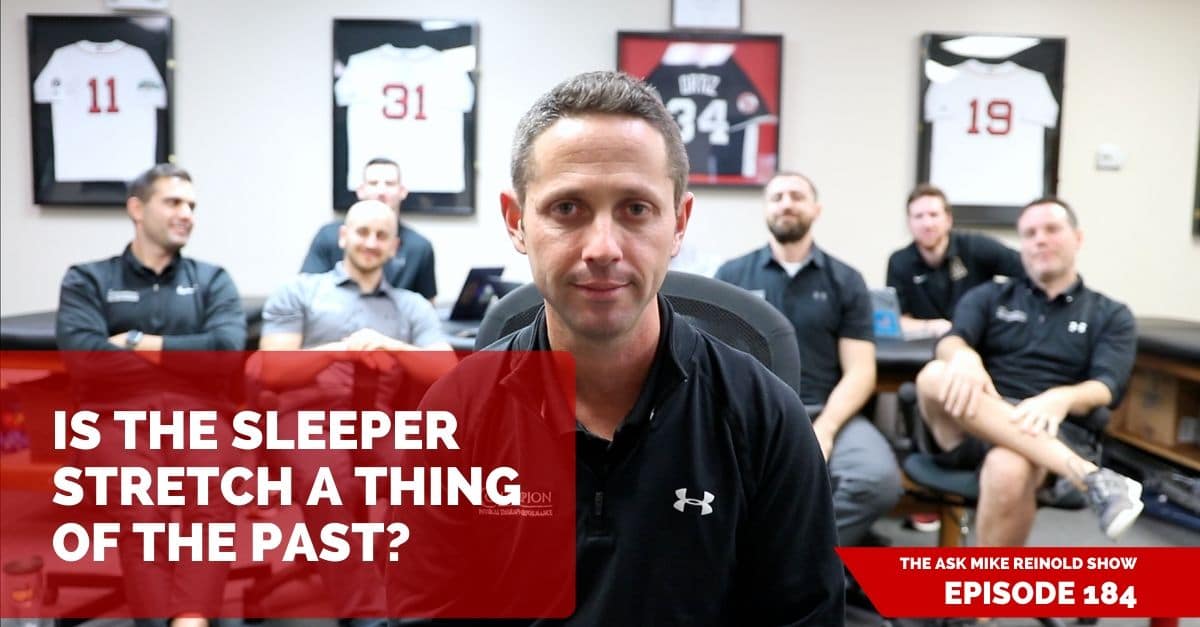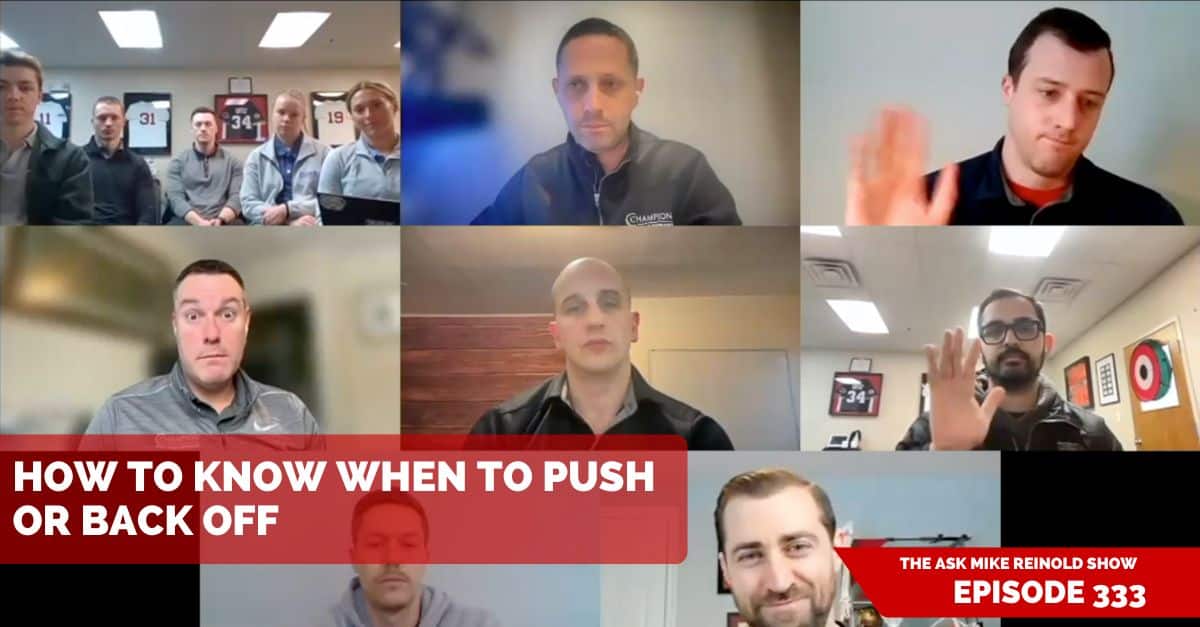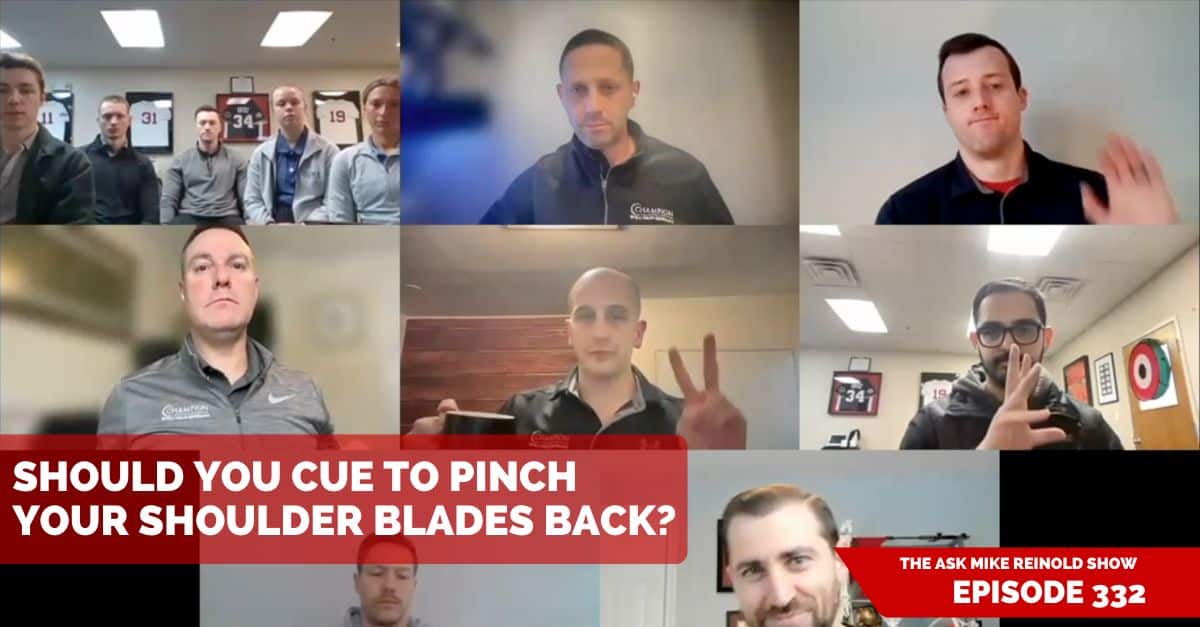On this episode of the #AskMikeReinold show we talk about using the sleeper stretch to restore internal rotation range of motion in the shoulder. There are probably more “cons” than “pros” with this stretch, but more importantly, probably better techniques we can do anyway. To view more episodes, subscribe, and ask your questions, go to mikereinold.com/askmikereinold.
#AskMikeReinold Episode 184: Is the Sleeper Stretch a Thing of the Past?
Listen and Subscribe to Podcast
You can use the player below to listen to the podcast or subscribe. If you are enjoying the podcast, PLEASE click here to leave us a review in iTunes, it will really mean a lot to us. THANKS!
Transcript
Mike Reinold: On this episode of the ask Mike Reinold Show, we talk about the sleeper stretch and if it’s a thing of the past or something that we still use here at Champion. Do we have a question from the audience today?
Student: We do. Brady from Iowa: Is the sleeper stretch a thing of the past? If so, what other options are there to address gird in overhead athletes?
Mike Reinold: So I’m going to throw it on the students here because I think I get why people are saying this, right? People still recommend the sleeper stretch. And you’re probably getting a script from a drug doctor that says do the sleeper stretch, right.
Lenny Macrina: I got one yesterday. But I don’t want to date the podcast, but if we could somehow pan the camera, which we’re not to the whiteboard. I put this on my Instagram and Twitter recently because I literally got a script from a doctor that said gird poster capsule, tight, sleeper stretch were the three things in a 13 year old softball player.
Mike Reinold: I’m going to send a script to a doctor with a patient that says do a meniscectomy. Just send it to the doctor when we send him in there.
Lenny Macrina: So we still get these in our area.
Mike Reinold: Did you guys learn sleeper stretch in school and did they say it was like a thing like you should use it?
Lenny Macrina: Do they teach it in school though? Is it a part of the curriculum or this is a social media thing?
Dave Tilley: I was never taught it.
Student: I wasn’t told it.
Student: We went over it one day in school as an option to increase IR but not really a specific application for [crosstalk 00:03:59].
Lenny Macrina: It could be that they’re just presenting all of the options. Right.
Mike Reinold: And don’t forget in the early two thousands there were some articles about how this was the greatest thing in the world.
Lenny Macrina: Sliced bread.
Mike Reinold: Right. So if you were to Google this and you were actually to like go on Pub Med or something, you would actually find articles that say it’s pretty good.
Lenny Macrina: Yeah.
Mike Reinold: But Brady, in all honestly you got dig in and read some of these articles that have on the website because we tackled some of the negatives as a sleeper stretch. So sleeper stretch is fine I guess. It’s torquing your arm into internal rotation but it really just assumes that your approach to restoring the range of motion is just to torque where there’s a lot of other options we could potentially do before we just started torquing it. And there’s a lot of negatives to the sleeper stretch to like the position of it. You could argue it’s an impingement based position. You could argue that the arthrokinematics of the joint are kind of awkward and it’s really sore. But I think the kicker that I always kind of tell everybody with this is, and this is kind of to answer your question, is the sleeper stretch bad or whatever he said is when you’re doing a stretch and you feel this sharp pain on the front of your shoulder and people are like, ah, yeah, that’s it.
Mike Reinold: That’s the feeling I want. I always tell him that that’s the equivalent of you flipping on your stomach and me stretching your knee and instead of feeling a nice stretch in the quad, you’re feeling a sharp pain on your tibial tuberosity. And you’re like, yeah, that’s it. Keep pushing. And that’s what we want. We would never do that with the knee. Right. And that’s kind of the same thing with the shoulder. So to answer your question about baseball and stuff, if you immediately just assume you do sleeperr stretch with somebody that has tight internal rotation, then you’re missing the boat potentially on this complete population of people on whether or not they even have a loss of internal rotation or if gird is normal. So based on that, let me open it up to you guys. Is there a population that you think sleeper stretch may be still applicable? Like rotator cuff repair or osteoarthritic or a adhesive capsulitis like a frozen shoulder or what do you guys think? Does anybody still do this?
Mike Scaduto: It definitely wouldn’t be where I would start at. I don’t think I’ve ever given a patient a sleeper stretch. I mean with like a rotator cuff repair, it doesn’t seem like a great position that you want to do.
Mike Reinold: Probably opposite.
Mike Scaduto: Definitely start with a way more gentle approach in terms of less aggressive stretching. Probably start with soft tissue, passive range of motion [crosstalk 00:06:13]. And if you’re getting some capsular tightness maybe do some low, low long- duration, but maybe not in that provocative of position, like the sleeper stretch. So probably not.
Mike Reinold: It seems like we’re jumping right to a really aggressive thing by going sleeper.
Dan Pope: I guess one thing I learned from you guys over the course of time, thank you very much and one thing that Lenny mentions a lot is that the posterior capsule is not necessarily a super robust structure.
Dan Pope: It’s not something that’s probably going to be limiting range of motion of time. So if you assess the capsule and maybe it is really stiff, maybe do you need to address it? The other part is that what is limited in turn rotation if that’s actually occurring, right. So we can work on some of that musculature and maybe do a cross body stretch or something that’s not going to irritate the joint further. We’re probably going to be more effective because the reason why I’ve in turn rotation of limitations, maybe not that capsule and even if it is capsule, probably not the intervention that you want choose first. Right.
Mike Reinold: Right.
Lenny Macrina: Let’s think about, we’ve talked about the capsule in the past and previous episodes and how we think we can potentially try to stretch it out is a prolonged stretch with a light load, right? So low, low long-duration. Are we going to have somebody lie on their side for 15 minutes and do a sleeper stretch and try to get posterior capsule stretching and just the concept just doesn’t make sense.
Lenny Macrina: And like he said, this is a very small population that may get a millimeter or two thickening of the posterior capsule that’s already the thinnest portion of the capsule anyway. If you look in the anterior and inferior portions of the glenohumeral capsule. So I think we’re missing the boat and we put a paper out in 2008 but if we’re talking baseball players that showed immediate changes in internal rotation, you lose internal rotation from throwing. There’s no way the capsule is becoming tight right after throwing, right? If we think it’s muscular tendonous and that’s probably where we should be targeting our efforts is in the muscle and the tendon, not the capsule. So I think we just, we completely missed the boat. We’ve gotten on this sleeper stretch thing and I’m guilty. I helped coauthor paper with Kevin Wilt and trying to come up with a modified sleeper stretch, put him in an open pack position [inaudible 00:08:05] roll him away so you’re not really lying on the shoulder joint.
Lenny Macrina: And I just think I’ve gotten away from it 100%. I know I hate to use this term but I never give it to anybody anymore. It’s not the most effective way in my opinion. I think this stretch, horizontally deduction has been shown to give similar results if not better results with people that have tightness in the back of their shoulder. Posterior shoulder tightness not posterior capsular tightness. We keep calling it the capsule and we’re giving it the wrong name I think from the get go.
Mike Reinold: So even if you have a limitation in IR, then the next question always comes down to what about a home exercise program? Because you can’t do manual therapy, can’t do soft tissue, that stuff.
Mike Reinold: And I think what Lenny’s getting to is just cross body kind of horizontally deduction is probably even better for that. So even the people that say, well but is sleeper stretch a good home exercise program? And I still think no. So we never ever use sleeper stretch here and I’ve never used sleeper stretch almost my entire career. I think the first time I did it a few times it’s like this is all wrong. I just had this, none of this makes sense, right? So I never really did it. I do not have problems with maintaining internal rotation in my people, especially baseball players. So is it a thing of the past? I think so. I think it really is. We don’t use it. And I would say we get a lot of people that come here that maybe were getting therapy elsewhere and one of the first things we do is we tell them to stop doing that.
Mike Reinold: And that was one of the thing that helps get them better, I think in my mind is they keep aggravating it by doing it more and more. So like I said, Brady, I apologize from the beginning again sort of. But head to my website. There’s a ton that you can read about that on the sleeper stretch. And I think you kind of digging a little bit on and make that decision yourself if it’s even the best thing to do. Even if it’s an option, is there a better option? Right. Does that make sense? So good question. Appreciate it. Head to mikereinold.com, click on that podcast link to ask us more questions just like that, but try to read my website first to answer the question yourself before. Anyway, sorry Brady, and then we’ll be sure to answer them. See you on the next episode.





